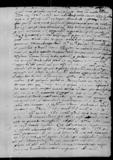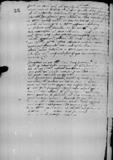List #7063
Ioannes DANTISCUS do Tiedemann GIESEs.l., [1539-05-25, postscripts 1539-05-26 and 1539-05-27]
Regest polski:
Poprzedniego dnia późnym wieczorem, kiedy Danytszek zakończył pisanie listu do Giesego [ta część listu jest zaginiona] nadeszła odpowiedź króla [Zygmunta I] w sprawie zmiany terminu i miejsca sejmu [pruskiego]. Dantyszek przesyła ją Giesemu. Uważa, że jego obszernie umotywowanej prośby, wyrażonej w imieniu wszystkich członków Rady Pruskiej, nie potraktowano wnikliwie i odpowiedziano mu, jakby prosił we własnym tylko imieniu. Przyczyny upatruje w niechęci kancelarii do wygotowywania nowych pism sejmowych. Wobec tego Dantyszek uważa za konieczne ponowne uzgodnienie terminu i miejsca spotkania oraz rozważenie, czy trzeba jeszcze raz prosić króla o zgodę.
Proponuje zwołać zjazd na 15 czerwca lub wcześniej do Malborka, a jeżeli tam nie ustąpi niebezpieczeństwo zarazy – w inne, bezpieczniejsze miejsce. Prosi adresata i sąsiadujących z nim panów o opinię w tej sprawie. Sam zapyta o zdanie wojewodę malborskiego [Jerzego Bażyńskiego], kasztelana gdańskiego [Achacego Cemę], a także radę Elbląga i radę Gdańska.
Podkanclerzy [Samuel Maciejowski] napisał, że zdaniem króla sprawa rozliczenia kontrybucji została wyczerpana we wcześniejszych poruczeniach.
Dantyszek załącza otrzymane nowiny. Modli się, by Bóg przywrócił adresatowi zdrowie. Uważa, że pod nieobecność Giesego sejm nie może się odbyć z właściwym skutkiem.
Po zakończeniu pisania pierwszego postscriptum Dantyszek otrzymał list od Giesego z pomyślnymi wiadomościami o jego powrocie do zdrowia. Dantyszek wyraża radość, a także nadzieję, że choroba uderzy teraz w tych, którzy źle Giesemu życzą i są przyczyną jego kłopotów. Deklaruje wsparcie przeciwko adwersarzom Giesego na najbliższym sejmie.
Książę [Albrecht Hohenzollern] przed dniem św. Stanisława [8 maja] poinformował Dantyszka, że król nakazał mu wysłanie swoich posłów na sejm [pruski], czego jednak nie mógł zrobić, toteż prosił o wyznaczenie kilku senatorów, z którymi mógłby spotkać się lub skontaktować przez wysłanników. Dantyszek poinformował go, że sejm z powodu zarazy został przełożony i obiecał powiadomić o nowym terminie i miejscu. Prosi Giesego, by również tę sprawę skonsultował z sąsiadującymi z nim panami.
Przesyła Giesemu list księcia oraz to, co książę chciał, by Giese przeczytał. Pierwsza ratyfikacja jest w rękach rady Torunia. Giese może z nimi ustalić, by dostarczyli ją na sejm.
[Mikołaj] Płotowski wyjaśni Giesemu, dlaczego nie wyjechał poprzedniego dnia od Dantyszka.
Rękopiśmienne podstawy źródłowe:
Publikacje:
| ||||||
Tekst + aparat krytyczny + komentarz Zwykły tekst Tekst + komentarz Tekst + aparat krytyczny Ekscerpty dotyczące podróży Dantyszka
Postscript No. 1:
 BCz, 245, p. 211
Cum has pridie maerens absolvissem, sera iam nocte
BCz, 245, p. 211
Cum has pridie maerens absolvissem, sera iam nocte
Ineundum igitur novum nobis erit consilium, ubi et quando nobis sit conveniendum, et si hoc ex nobis ipsis sit statuendum, an iterum pro consensu ad
De ratione contributionis scribit mihi reverendus dominus
Quae ad me nova cf.
Postscript No. 2:
Reverendissime mi Domine.
Cum ab hac scheda commodum superinscribed⌈commodumcommodum superinscribed⌉ manum amovissem, adfuit hidden by binding⌈[it]it hidden by binding⌉
cf.
Remitto ea, quae
ill(ustrissimus) or ill(ustris)⌈ill(ustrissimus)ill(ustrissimus) or ill(ustris)⌉
dominus
Heri dominus

